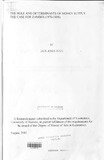| dc.description.abstract | This study is an attempt to evaluate the role and determinants of money supply in Zambia
using the money multiplier approach over a period of 28 years (1970-1998). Various
factors were analysed and from the results it is vividly clear that the constituents of
money supply are diverse and unique in their own right Fiscal operations reflected in
significant Bank of Zambia claims on government (BOZCG) which go to finance
government expenditure (GEXP) were found to have a dominant influence on the money
supply growth patterns in the economy. This empirical evidence is consistent with the
commonly held view that there is a close link between fiscal operations and growth in
money supply
The overall impact of balance of payments (BOP) was found to be good for a build up of
foreign reserves at the central bank and their total effect on money supply was rather
insignificant. Past changes in Net Foreign Assets (NFAt-1) were also found to have
some fairly significant dominance in explaining money supply patterns- a condition that
suggests that the central bank does not completely sterilise the effects of external
influence on the domestic economy. The cash (C/M1) and excess reserve (R/M1) ratios
were found to be significantly influenced by changes in the real income (GDP).
The study also brings to the fore the aspect that the exchange rate (XRTE) if left to its
own devices as the case is now, could be a source of destabilisation to money supply
.growth rate and hence needs to be watched closely. In this regard, it was felt that a
managed float as opposed to a complete float would be ideal under the current scenario
where most economic fundamentals such as GDP growth rate, export earnings, and the
manufacturing sector are not performing well. It was further n.oted that since the central
bank is not completely free from political influence, the bank should therefore intensify
the usage of OMOs and discount rates as tools for mopping excess liquidity from the
main arteries of the economy, | en |

